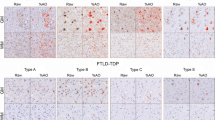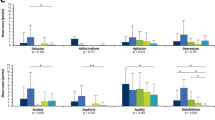Abstract
Pathology underlying behavioral variant frontotemporal dementia (bvFTD) is heterogeneous, with the most common pathologies being Pick’s disease (PiD), corticobasal degeneration (CBD), and FTLD-TDP type 1. Clinical features are unhelpful in differentiating these pathologies. We aimed to determine whether imaging atrophy patterns differ across these pathologies in bvFTD subjects. We identified 15 bvFTD subjects that had volumetric MRI during life and autopsy: five with PiD, five CBD, and five FTLD-TDP type 1. Voxel-based morphometry was used to assess atrophy patterns in each bvFTD group compared to 20 age- and gender-matched controls. All three pathological groups showed gray matter loss in frontal lobes, although specific patterns of atrophy differed across groups: PiD showed widespread loss in frontal lobes with additional involvement of anterior temporal lobes; CBD showed subtle patterns of loss involving posterior lateral and medial superior frontal lobe; and FTLD-TDP type 1 showed widespread loss in frontal, temporal, and parietal lobes. Greater parietal loss was observed in FTLD-TDP type 1 compared to both other groups, and greater anterior temporal and medial frontal loss was observed in PiD compared to CBD. Imaging patterns of atrophy in bvFTD vary according to pathological diagnosis and may therefore be helpful in predicting these pathologies in bvFTD.


Similar content being viewed by others
References
Ashburner J, Friston KJ (2000) Voxel-based morphometry—the methods. Neuroimage 11:805–821
Ashburner J, Friston KJ (2005) Unified segmentation. Neuroimage 26:839–851
Bigio EH, Lipton AM, Yen SH et al (2001) Frontal lobe dementia with novel tauopathy: sporadic multiple system tauopathy with dementia. J Neuropathol Exp Neurol 60:328–341
Boccardi M, Sabattoli F, Laakso MP et al (2005) Frontotemporal dementia as a neural system disease. Neurobiol Aging 26:37–44
Cairns NJ, Grossman M, Arnold SE et al (2004) Clinical and neuropathologic variation in neuronal intermediate filament inclusion disease. Neurology 63:1376–1384
Cairns NJ, Bigio EH, Mackenzie IR et al (2007) Neuropathologic diagnostic and nosologic criteria for frontotemporal lobar degeneration: consensus of the Consortium for Frontotemporal Lobar Degeneration. Acta Neuropathol 114:5–22
Dickson DW (2001) Neuropathology of Pick’s disease. Neurology 56:S16–20
Dickson DW, Bergeron C, Chin SS et al (2002) Office of Rare Diseases neuropathologic criteria for corticobasal degeneration. J Neuropathol Exp Neurol 61:935–946
Folstein MF, Folstein SE, McHugh PR (1975) Mini-mental state. A practical method for grading the cognitive state of patients for the clinician. J Psychiatr Res 12:189–198
Hauw JJ, Daniel SE, Dickson D et al (1994) Preliminary NINDS neuropathologic criteria for Steele-Richardson-Olszewski syndrome (progressive supranuclear palsy). Neurology 44:2015–2019
Hu WT, Mandrekar JN, Parisi JE et al (2007) Clinical features of pathologic subtypes of behavioral–variant frontotemporal dementia. Arch Neurol 64:1611–1616
Josephs KA (2008) Frontotemporal dementia and related disorders: deciphering the enigma. Ann Neurol 64:4–14
Josephs KA, Holton JL, Rossor MN et al (2003) Neurofilament inclusion body disease: a new proteinopathy? Brain 126:2291–2303
Josephs KA, Petersen RC, Knopman DS et al (2006) Clinicopathologic analysis of frontotemporal and corticobasal degenerations and PSP. Neurology 66:41–48
Josephs KA, Whitwell JL, Dickson DW et al (2008) Voxel-based morphometry in autopsy proven PSP and CBD. Neurobiol Aging 29:280–289
Josephs KA, Stroh A, Dugger B, Dickson DW (2009) Evaluation of subcortical pathology and clinical correlations in FTLD-U subtypes. Acta Neuropathol 118:349–358
Josephs KA Jr, Whitwell JL, Weigand SD et al (2010) Predicting functional decline in behavioural variant frontotemporal dementia. Brain 134:432–448
Le Ber I, Guedj E, Gabelle A et al (2006) Demographic, neurological and behavioural characteristics and brain perfusion SPECT in frontal variant of frontotemporal dementia. Brain 129:3051–3065
Mackenzie IR, Baborie A, Pickering-Brown S et al (2006) Heterogeneity of ubiquitin pathology in frontotemporal lobar degeneration: classification and relation to clinical phenotype. Acta Neuropathol Berl 112:539–549
McKhann GM, Albert MS, Grossman M, Miller B, Dickson D, Trojanowski JQ (2001) Clinical and pathological diagnosis of frontotemporal dementia: report of the Work Group on Frontotemporal Dementia and Pick’s Disease. Arch Neurol 58:1803–1809
Mirra SS, Heyman A, McKeel D et al (1991) The Consortium to Establish a Registry for Alzheimer’s Disease (CERAD). Part II. Standardization of the neuropathologic assessment of Alzheimer’s disease. Neurology 41:479–486
Neary D, Snowden JS, Gustafson L et al (1998) Frontotemporal lobar degeneration: a consensus on clinical diagnostic criteria. Neurology 51:1546–1554
Rohrer JD, Geser F, Zhou J et al (2010) TDP-43 subtypes are associated with distinct atrophy patterns in frontotemporal dementia. Neurology 75:2204–2211
Rosen HJ, Allison SC, Schauer GF, Gorno-Tempini ML, Weiner MW, Miller BL (2005) Neuroanatomical correlates of behavioural disorders in dementia. Brain 128:2612–2625
Sampathu DM, Neumann M, Kwong LK et al (2006) Pathological heterogeneity of frontotemporal lobar degeneration with ubiquitin-positive inclusions delineated by ubiquitin immunohistochemistry and novel monoclonal antibodies. Am J Pathol 169:1343–1352
Seeley WW, Crawford R, Rascovsky K et al (2008) Frontal paralimbic network atrophy in very mild behavioral variant frontotemporal dementia. Arch Neurol 65:249–255
Snowden JS, Bathgate D, Varma A, Blackshaw A, Gibbons ZC, Neary D (2001) Distinct behavioural profiles in frontotemporal dementia and semantic dementia. J Neurol Neurosurg Psychiatry 70:323–332
Snowden J, Neary D, Mann D (2007) Frontotemporal lobar degeneration: clinical and pathological relationships. Acta Neuropathol 114:31–38
Snowden JS, Hu Q, Rollinson S et al. (2011) The most common type of FTLD-FUS (aFTLD-U) is associated with a distinct clinical form of frontotemporal dementia but is not related to mutations in the FUS gene. Acta Neuropathol. doi:10.1007/500401-011-0816-0
Urwin H, Josephs KA, Rohrer JD et al (2010) FUS pathology defines the majority of tau- and TDP-43-negative frontotemporal lobar degeneration. Acta Neuropathol 120:33–41
Whitwell JL, Josephs KA, Rossor MN et al (2005) Magnetic resonance imaging signatures of tissue pathology in frontotemporal dementia. Arch Neurol 62:1402–1408
Whitwell JL, Jack CR Jr, Senjem ML et al (2009a) MRI correlates of protein deposition and disease severity in postmortem frontotemporal lobar degeneration. Neurodegener Dis 6:106–117
Whitwell JL, Przybelski SA, Weigand SD et al (2009b) Distinct anatomical subtypes of the behavioural variant of frontotemporal dementia: a cluster analysis study. Brain 132:2932–2946
Whitwell JL, Jack CR Jr, Boeve BF et al (2010a) Imaging correlates of pathology in corticobasal syndrome. Neurology 75:1879–1887
Whitwell JL, Jack CR Jr, Parisi JE et al (2010b) Does TDP-43 type confer a distinct pattern of atrophy in frontotemporal lobar degeneration? Neurology 75:2212–2220
Acknowledgments
The authors would like to acknowledge Dr. Rosa Rademaker and Matt Baker, Mayo Clinic Jacksonville FL, for performing the genetic analysis. This study was funded by grants NIH R01 DC10367, R01 AG37491, R21 AG38736, RO1 AG11378, and P50 AG16574.
Author information
Authors and Affiliations
Corresponding author
Rights and permissions
About this article
Cite this article
Whitwell, J.L., Jack, C.R., Parisi, J.E. et al. Imaging Signatures of Molecular Pathology in Behavioral Variant Frontotemporal Dementia. J Mol Neurosci 45, 372–378 (2011). https://doi.org/10.1007/s12031-011-9533-3
Received:
Accepted:
Published:
Issue Date:
DOI: https://doi.org/10.1007/s12031-011-9533-3




